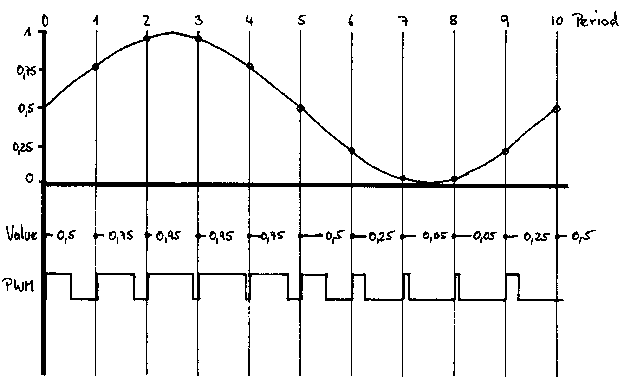.
When you look at the frequencies (each key produces it's two according
row and column frequencies), you can guess, that they don't repeat early.
But I found a trick: Since our bit resolution is restricted anyway (remember
we have only 80 different values for the width register), we don't have
to worry whether the wave form reached 0 or 0.001. In other words: If you
consider the limited sampling resolution, you can find repetitions after
500 - 1000 sample values (I wrote a program on my desktop to find that
'unaccurate correlation'). Now everything is easy: Store the values on
your Palm (it takes about 9k for that data) and read them out to the width
register. Well, there is one more problem to overcome. Since the processor
has to reload the width register every 20uSec, the reaction time on that
'period-done-bit' is crucial for the quality of the signal. If a new period
is more or less delayed, you'll get a jitter in your output signal, that
distorts it. Since the Palm is an event driven machine, it is better to
switch off all interrupts during that short sound output. But some machines,
configurations, hacks, whatever don't like that obviously. So you'll find
two different versions of the app in the archiv. DTMF_INT leaves the interrupts
on and has a slightly worse sound quality (if to speak of sound quality
anyway <g>). The file DTMF_!!! is the 'dangerous' one that disables
the interrupt. Try it, if your Palm crashes, a simple soft reset should
cure it :)
.
Download DTMF.ZIP (12k)
(Freeware)
.
DTMF is a simple push-button solution in the moment. If there would
be a possibility to overcome the hardware weaknesses, it would be possible
of course, to code it for example as a hack, that allows direct dialing
from an address book entry. The keys A to D are producing _not_ the usual
dual tones, but pure sine waves for test purposes (if you happen to have
a spectrum analyser like me, you will love it <g>). A to D sines are
700, 1000, 1300 and 1600 Hz. Also, the tone duration is quite long, but
that's also better if you want to meassure something. Remember, it's a
pure test app. I wouldn't have posted it, if I hadn't got so many mails
about it :)
.
Since I stated, that with the PWM module _any_ waveform can be reproduced,
I hacked together a little testapp, called TALK. Talk plays a 2 second
voice sample. You better hold the back of your Palm close to your ear (best
is, if you hear the constant hiss of the piezo already). Then tap the button
(you'll find it blind, that's why it is so big <g>). You should hear:
'Hello everyone, I'm a talking Pilot' (Sorry 3Com, I don't code 'Palm'
now instead of 'Pilot' into that old app <g>). As I said, due to the
various lacks of the hardware, the quality is lousy, but I think it's understandable
and the basics are proved. If you still have good ears, you can clearly
hear the 16kHz sample frequency that's coming through unfiltered (used
16 kPeriods/sec for that one, otherwise it had taken too much memory).
It's a fun app, but hey, you can say: My Palm talks! :)
.
Download TALK.ZIP (34k)
(Freeware)
.
ATTENTION: Talk is a simple demo software, but uses alot of
heap space on your Palm! People reported, that TALK behaves strange on
low or fragmented memory. You can start TALK then, but tapping the button
produces nothing. Worse: Since TALK is still running, you can't remove
it with the memory manager then. Don't panic :). Just perform a normal
soft reset, then you can delete TALK quite normal from your Palm. You could
also try out Recycle prior to installing
TALK, a very good defragger for the Palm memory.
.
|
